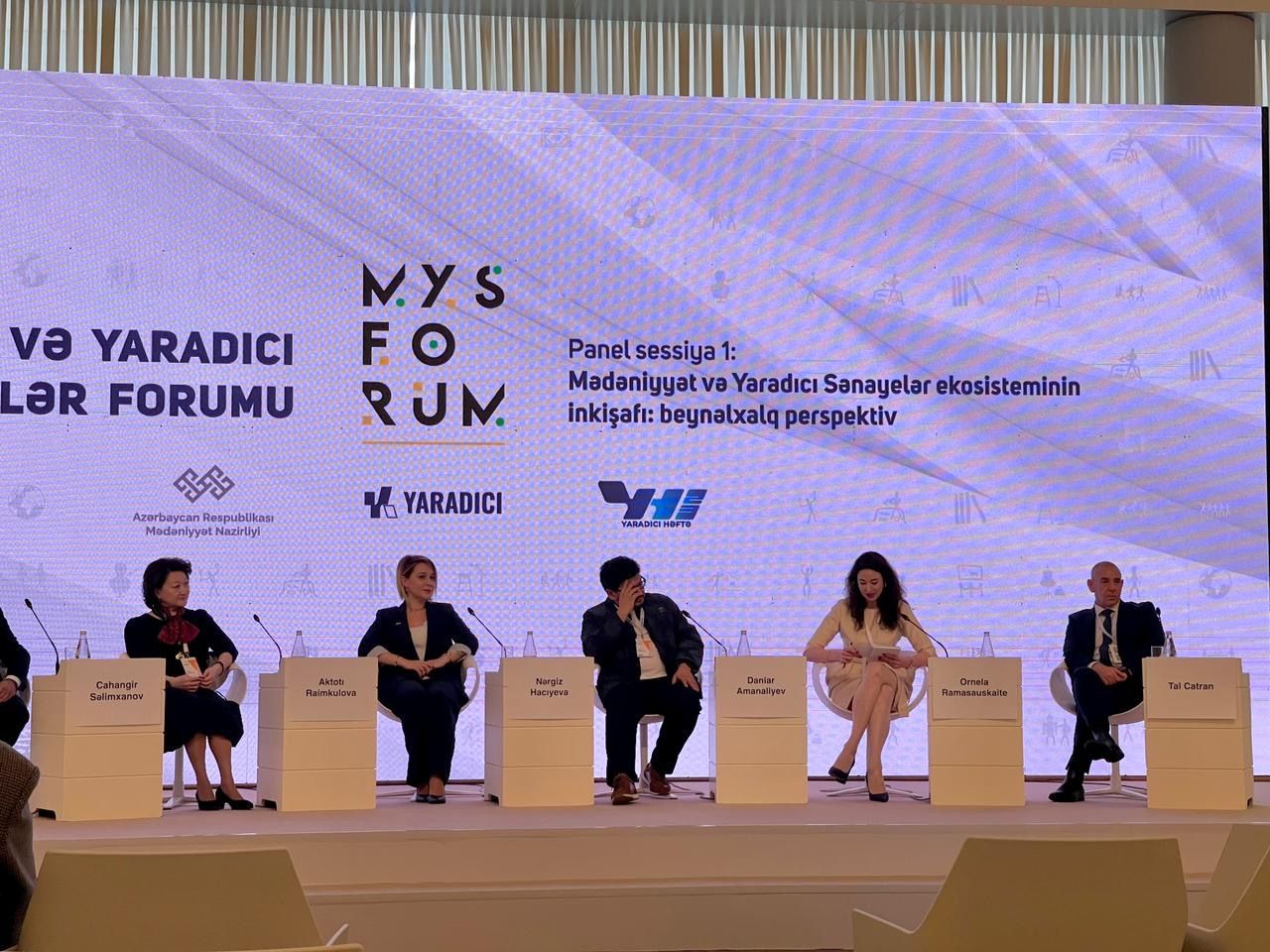CEO of artXchange Global Azerbaijan has potential to become beacon in creative & artistic industries [EXCLUSIVE]
![CEO of artXchange Global Azerbaijan has potential to become beacon in creative & artistic industries [EXCLUSIVE]](https://www.azernews.az/media/2023/12/01/2_ornela_ramasauskaite.jpg)
The creative industries encompass a wide range of sectors, including design, advertising, architecture, fashion, film, music, and more.
These industries play a vital role in cultural enrichment and economic growth.
By bringing together experts from different backgrounds, the forum creates an environment conducive to exchanging ideas and promoting the development of creative sectors in Azerbaijan.

In an interview with AZERNEWS, international art market expert and CEO of artXchange Global, Ornela Ramasauskaite, shares her views on the future prospects for creative industries in the country.
The expert touches upon the impact of creative industries on economy and major challenges that creative industries are facing today
Q: What is your overall impression of the Forum of Culture and Creative Industries in Baku? What interesting topics were brought to attention at the forum?
A: The Forum of Culture and Creative Industries in Baku was not only a convergence of diverse cultural perspectives but also a dynamic platform for charting the course of Azerbaijan's creative future. It was clear that the Ministry of Culture has a robust and clear vision for cultural development, supported by a solid and motivated team. Including international experts underscores a commitment to adopting best practices tailored to the Azerbaijani context.
The discussions were particularly forward-thinking, focusing on the creative economy and embracing digitization to extend the reach of cultural goods and services. The ambition to export cultural goods, embrace technology in the arts, and invest in high-potential areas such as the gaming and animation industries was evident. This approach, blending global trends with local authenticity, or the "glocal" perspective, demonstrates a sophisticated strategy to make culture a point of national pride and a profitable enterprise.
During the conference, I met numerous devoted and incredibly talented artists, further solidifying my belief in the country's creative potential. Their passion and talent are integral to defining Azerbaijan's brand on the international stage. It's heartening to see cultural and creative goods recognised as expressions of national identity and valuable economic assets. The collective understanding shared by stakeholders and the hands-on approach observed are solid foundations for swift and targeted implementation, heralding a successful integration of culture into the nation's economic growth narrative.
Q: How have creative industries influenced the economy in general?
A: The creative industries have become vital to the global economy, showcasing their importance through various studies and theories. Research by Boix and Soler (2017) measured the size of the creative industries for 250 regions in 24 countries of the EU, finding that creative industries generated 7.8% of the total production (GDP). This is a significant figure, especially considering the diverse and rich tapestry of industries within the EU.
Employment within the Creative Economy is also noteworthy. This sector employed 7 million people in Europe, or 3.3% of the active population. The diversity within these jobs is remarkable, with industries such as performing arts, visual arts, and music each employing over a million people. This level of employment is comparable to major industries like food and beverage services, underscoring the Creative Economy's crucial role in job creation.
Another exciting aspect is the impact of these industries on youth employment. In Europe, the Creative and Cultural Industries (CCIs) employed a higher percentage of 15 to 29-year-olds than other sectors. This suggests that CCIs are significant employers and are particularly appealing and accessible to younger demographics.
Looking beyond Europe, the significance of CCIs is also evident in developing and emerging countries. In places like China, Latin America, the Caribbean, Africa, and the Middle East, these sectors contribute notably to GDP and employment. However, it's important to note that in many of these regions, the full impact of CCIs might be understated due to the informal nature of these sectors.
Its revenue generation and e-commerce growth further underscore the global reach of the Creative Economy. UNESCO reported that this sector generates annual global revenues of US$2.25 trillion, with a substantial portion coming from digital sales. This highlights not just the economic scale of the industry but also its adaptability and growth in the digital age.
Moreover, the sub-sector of collectable art and antiques, though smaller, had significant turnovers, indicating the varied nature of the creative industries. Global art sales, in particular, have shown resilience and adaptability, with online sales gaining prominence.
The geographic distribution of the art market is also telling, with significant concentrations in the United States, Europe, and China, yet serving a global clientele. This reflects the globalised nature of the art market and its wide-reaching influence.
Richard Florida's theory of the Creative Class further enhances our understanding of the economic impact of creative industries. According to Florida, regions with high concentrations of technology workers, artists, and musicians and a high level of diversity and tolerance tend to have higher economic development. This aligns with the data showing the significant contributions of creative industries to economies worldwide.
In essence, the creative industries are a significant contributor to global GDP and employment and play a pivotal role in shaping socioeconomic landscapes. They influence urban development and cultural diversity and are at the forefront of the digital transformation of the economy.
Q: What are the major challenges that creative industries are facing today?
The significant challenges facing today's creative industries are multifaceted, evolving from both internal dynamics and external pressures.Firstly, digital transformation stands as a double-edged sword. While it offers creative industries unprecedented access to global markets, it also demands a rapid and continuous adaptation of skills, business models, and marketing strategies. The pace of technological change can outstrip the ability of creative organizations to keep up, potentially leading to a digital divide where only those with the resources to adapt can thrive.
Intellectual property rights pose another significant challenge. In the digital age, where content can be shared and replicated instantly, protecting the rights of creators and investors is more complex than ever. Ensuring fair compensation for creators while balancing the public's access to creative works is a contentious issue that remains unresolved. This is exacerbated by varying international laws and enforcement practices, making creating a standardized approach to intellectual property rights difficult.
Sustainable funding models are also a critical challenge. New consumption habits are disrupting traditional revenue streams, such as the preference for streaming over physical media and the expectation of free online content. Finding models that sustain the financial health of creative industries while appealing to modern consumers is an ongoing struggle. This includes monetization and investment in new projects and talents, which is crucial for the vitality and innovation within these industries.
Despite these challenges, they also present opportunities. Digital transformation, for instance, can enable creative industries to explore new forms of storytelling and audience engagement, opening up possibilities like virtual and augmented reality. Intellectual property rights debates spur discussions on balancing creator incentives with public domain enrichment, potentially leading to more nuanced and forward-thinking legislation. Sustainable funding models encourage innovation in finance, such as crowdfunding and micro-patronage, empowering consumers to support the content they value directly. Also, integrating international expertise can accelerate growth and help avoid pitfalls, drawing on successful models like Lithuania's Arm's Length Body for cultural governance.
Ultimately, the ability of the creative industries to navigate these challenges will determine their resilience and capacity to contribute to economic and cultural landscapes globally. It's an ongoing negotiation, innovation, and adaptation process that will define the future of creative industries.
Q: In your opinion, what kind of measures should be taken for further development of creative industries?
A: A multifaceted strategy must be employed to develop creative industries further. Central to this is the renewal of the education system to ensure that upcoming generations possess creative skills and the business acumen necessary to navigate the modern landscape. Education should bridge traditional artistry with contemporary IT and marketing skills, fostering innovation and adaptability.
The establishment of an Arm's Length Body is another critical measure. This organization should fund, shape, and monitor cultural organizations and artists. By operating at arm's length from governmental influence, such a body can ensure that artistic and cultural development is maintained without political bias while also guaranteeing transparency and accountability in the allocation of resources.
A global approach is essential in an interconnected world; it allows for the cross-pollination of ideas and best practices. International experts can provide insights into global market trends, offer new perspectives on creativity and management, and help bridge the gap between local talent and international standards. They can assist in developing networks that facilitate the global exchange of cultural goods and services, ensuring that local creative industries are sustainable and competitive on the world stage.
Q: What are the potential future prospects for creative industries in Azerbaijan? Do you think that the forum will boost the development of creative industries in the country?
A: The potential prospects for Azerbaijan's creative industries are anchored in the country's deep cultural heritage and recent initiatives to catalyze growth in this sector. The rich cultural landscape of Garabagh, with its unique history, offers a fertile ground for the development of creative industries such as music, literature, visual arts, and crafts. This cultural wealth can be harnessed to create an internationally distinctive brand for Azerbaijan.
The importance of international forums and conferences cannot be overstated. They provide a platform for stakeholders from various facets of the creative industries to converge, share ideas, and forge partnerships. Such events can significantly boost the development of creative industries by promoting dialogue, fostering collaboration, and attracting investment. They also spotlight the country's commitment to these sectors, signalling to potential investors and international markets about Azerbaijan's dedication to cultivating its cultural industries.
For Azerbaijan to fully realize the potential of its creative industries, there needs to be a concerted effort towards strategic planning and investment. Adopting a long-term investment strategy with at least a five-year horizon is crucial for achieving measurable progress regarding Key Performance Indicators (KPIs). This approach ensures that initiatives are not just flash-in-the-pan efforts but are sustainable and yield growth and development over time.
The Ministry of Culture's commitment, coupled with the support from key decision-makers, is a strong indicator of the government's belief in the potential of these industries. This level of support is essential for creating an enabling environment where creative industries can thrive.
Incorporating international experts brings global perspectives and best practices into the local context, which can accelerate growth and innovation. Furthermore, investing in education that bridges art and commerce is vital. It's about nurturing creativity and equipping creative professionals with the business acumen to market and monetize their talents effectively.
By taking these steps, Azerbaijan positions itself to enhance its cultural footprint significantly. The nation has the potential to become a beacon in the global creative and artistic industries, drawing on its rich heritage to build a vibrant, sustainable, and innovative creative economy.
---
Laman Ismayilova is AzerNews’ staff journalist, follow her on Twitter: @lmntypewriterrr
Follow us on Twitter @AzerNewsAz
Here we are to serve you with news right now. It does not cost much, but worth your attention.
Choose to support open, independent, quality journalism and subscribe on a monthly basis.
By subscribing to our online newspaper, you can have full digital access to all news, analysis, and much more.
You can also follow AzerNEWS on Twitter @AzerNewsAz or Facebook @AzerNewsNewspaper
Thank you!



